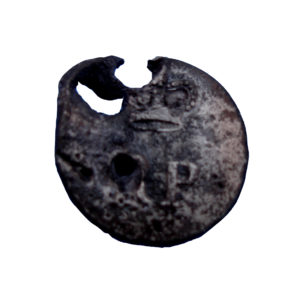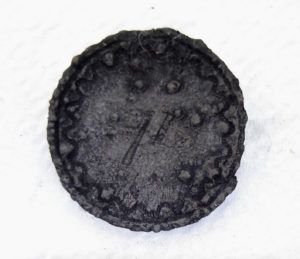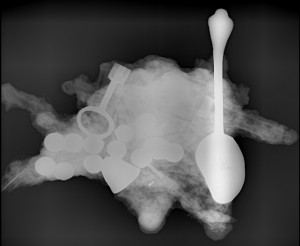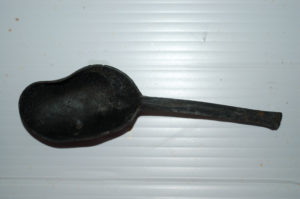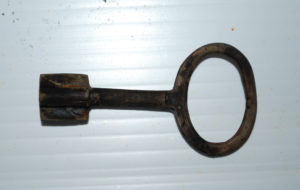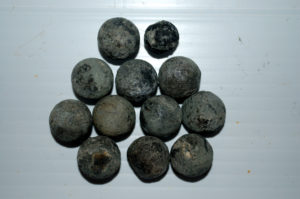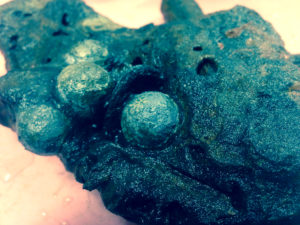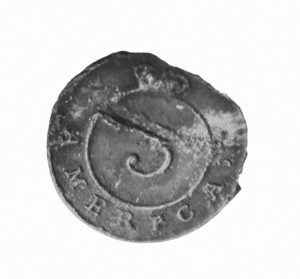Some of the most exciting finds from the Storm Wreck have been the smallest artifacts.
Two military buttons were found while excavating and conserving objects. They helped provide some of the best diagnostic information about the ship and what it was doing.
The first button was found while removing concretion from the exterior of a larger artifact, the ship’s bell. The bell was excavated and began conservation treatment in 2011, and while being cleaned, a small pewter button with the letters “RP” were found in the hardened sediment.
The button belonged to a Royal Provincial (RP) soldier, someone who lived in America and remained loyal and fought for the British during the American Revolution. It was one of our first clues as to who was on board when the ship went down.
The second button was discovered while sorting through dredge spoil from the summer field season. Excavating on site requires the use of dredges to remove the surrounding sand in order to get to the artifacts below. Essentially, they are large underwater vacuums that suck up the unwanted sand, silt and shell and deposit it a few meters away. We use filter screens and mesh bags to catch the larger material at the end of the deposition hose just in case smaller objects of interest get picked up by the suction. Later, on land, the bags are dumped into buckets and sorted so as not to miss anything.
It was during this sorting that a small pewter button with the numbers “71” was found. This was a button off a uniform of the 71st Regiment, a military unit raised in Scotland that fought for the British crown. One of their last assignments was to help with the evacuation of Charleston in 1782.
Because of these two discoveries and the wealth of knowledge they provided, an eye has been kept out for the possibility of new buttons. Each concretion is X-rayed after being excavated and brought back to the conservation lab. Some X-rays clearly have buttons in them, while others are harder to determine. These concretions are all flagged, though, for conservation.
One such concretion was not flagged solely for a button, but had multiple interesting artifacts within. At first glance, a spoon, numerous musket balls, a key and an oblong thimble-looking shape could be seen in addition to a button.
Conservation began by air scribing out the spoon, the brass key and as many of the musket balls as possible. This proved difficult due to the close proximity of the shot and the soft nature of the lead artifacts. When the air scribe was too large to fit in between the shot, dental tools were used to scrape away sediment and pop out the musket balls.
The pewter spoon was the first to come out, but has no unique or distinguishable markings.
The second piece removed was the brass key, which appears to be for a padlock.
Next were the musket balls. There were eleven .69 caliber musket balls and one .50 caliber pistol ball in the concretion.
As previously mentioned, there was one button identified in the X-ray. Two additional buttons were found while cleaning the artifacts, however. The first button was small, pewter and had the number “3” in the center with a royal crown above and “American” below. This button belonged to a soldier from the 3rd American Regiment, also known as the New York Volunteers.
They were a military unit raised in 1776 and sent to East Florida in 1778. They were present for a handful of engagements in the southeast and assisted in the evacuation of Charleston in 1782. Finding this button was very exciting because it helps corroborate the theory about the Storm Wreck.
The other two buttons were unexpected. Due to the nature of X-rays, the material in the concretion and the nature of the deposition, the buttons looked like the musket balls. Fortunately, as the artifacts were removed, it became clear that they were actually two large pewter buttons with a royal crown on top and “RP” in the center.
Overall, they are the same design as the first “RP” button found and conserved years earlier, only larger and in better condition. These two buttons are equally as exciting to find because they too substantiate our interpretation of the wreck and that our first Royal Provincial find wasn’t an outlier.
Next time you’re visiting the museum, take a guided Lost Ships tour with one of our archaeologists and you can see these lead pieces along with other artifacts from the Storm Wreck!
Andrew Thomson is the Assistant Conservator for the St. Augustine Lighthouse & Maritime Museum. He received his graduate degree and training from the Conservation Research Laboratory at Texas A&M.


